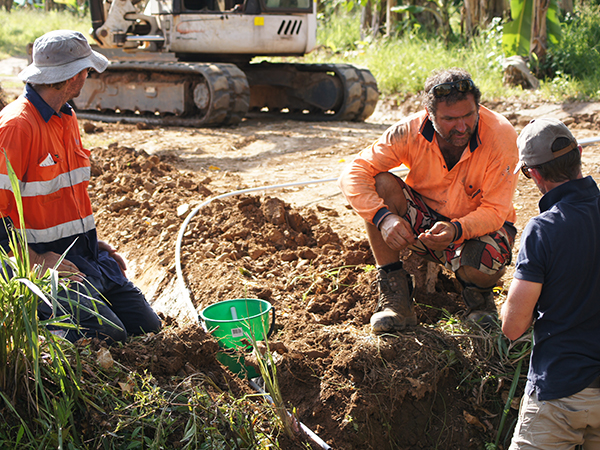All treatment systems go!

Banana farmer Rob Zahra with Mike Back (L) and Butch Uechtritz (R) from Turbid Water Solutions retrofitting a HES basin to an existing irrigation dam.
Farmers in Far North Queensland are trialling proof-of-concept treatment systems in what could be new lines of defence for the Great Barrier Reef.
Man-made wetlands, an in-drain wetland, a denitrification bioreactor and high efficiency sediment basin are all treatment technologies being trialled to reduce the amount of nutrients, sediments and pesticides flowing to the reef.
The technologies are being implemented as part of the Wet Tropics Major Integrated Project (MIP), a community-designed reef water quality project that focuses on water quality hotspots, the Tully and the Johnstone. Monitoring data will help build a more comprehensive story about the effectiveness of different treatment systems in far North Queensland.
Sandra Henrich from the Wet Tropics MIP said the project responds to demand for relevant, local information about water quality, and solutions that are informed by landscape conditions and local knowledge.
“This project has been designed for local by locals. Growers want to make informed decisions that help reduce risk of nitrogen, sediment and pesticide run-off, without compromising productivity or profitability,” she said.
Bioreactors are an engineered landscape feature used to remove nitrogen from groundwater before it enters local waterways. Sub-surface water flows through the bioreactor and, under the anaerobic conditions, naturally-occurring bacteria convert the dissolved inorganic nitrogen into a gas which is then dispersed into the atmosphere.
Bioreactors for the control of nitrate in agricultural catchments are not a new technology internationally, but as of 2017 there were only two bioreactors in Australia, both installed in South East Queensland. There are now bioreactors installed in the Innisfail area, Babinda and Townsville.
A high efficiency sediment (HES) basin has also been installed on a banana farm in the Innisfail area. A HES basin is engineered to capture sediment, and associated nutrients and pesticides from agricultural water before it enters local waterways. Coagulant is added to the basin through a rainfall-activated dosing system, which makes sediment particles settle on the bottom.
“HES basins as a treatment option can be of particular interest to growers concerned with fine sediments erosion,” Sandra said. “HES basins are often used in the mining and building industries, but they are in the trial stage in agricultural environments in Queensland. In this instance the coagulant dosing system was retrofitted to an existing irrigation dam.”
Banana farmer Rob Zahra said it will be interesting to see the results.
“All of my farm run-off goes into this irrigation dam which then gets recycled,” he said. “If I can reduce the sediment in my water it’s definitely going to improve the efficiency of my irrigation system. If I’ve got better water quality in my dam I’ve also got better water to put on my bananas. I also think if this project delivers the results that we think it may, it could be quite a good exercise for other growers to adapt into their farming procedures to help improve the quality of water headed for the Great Barrier Reef.”
The Wet Tropics Major Integrated Project is funded by the Queensland Government through the Reef Water Quality Program.



